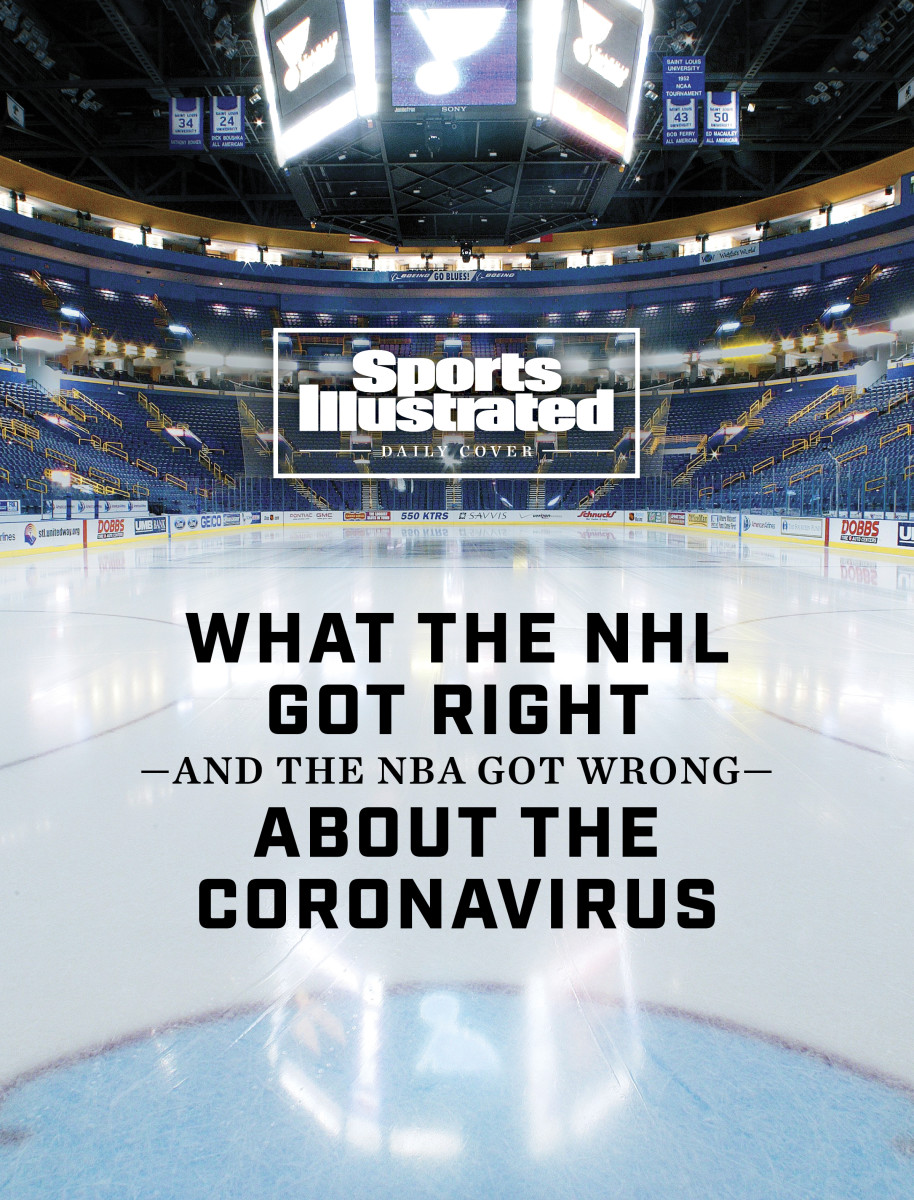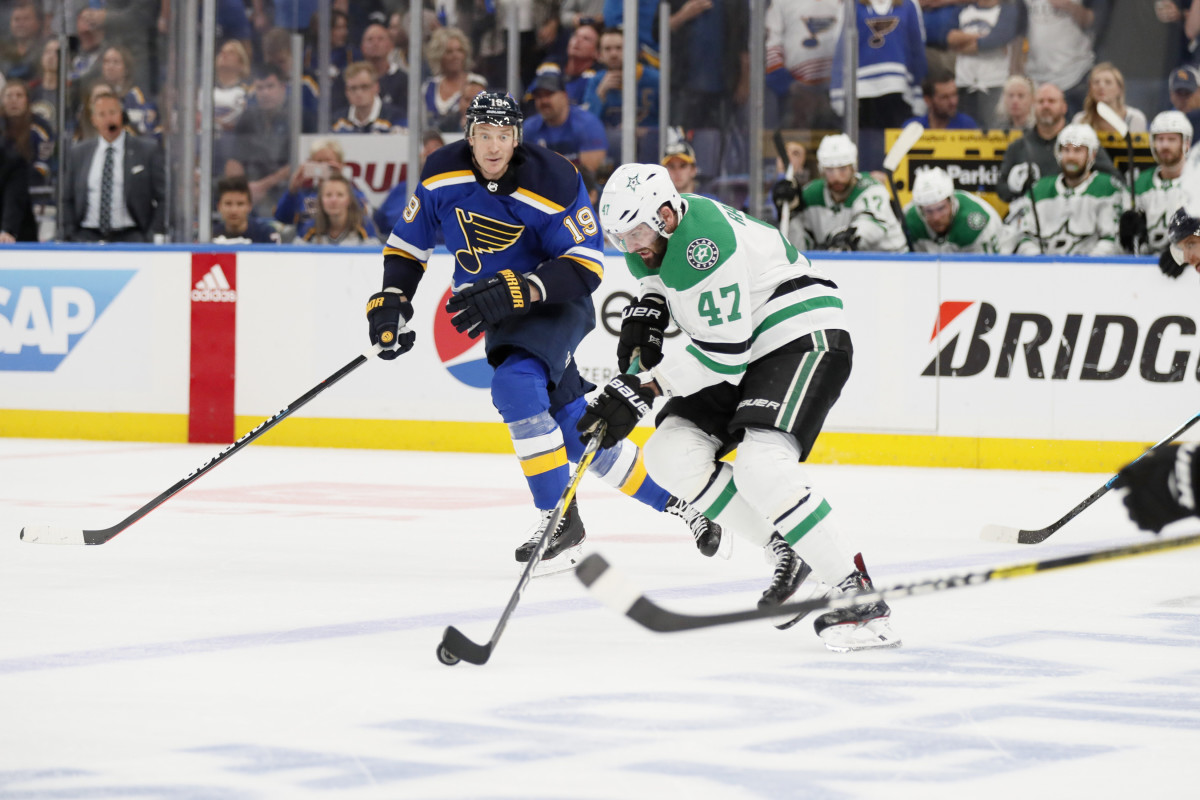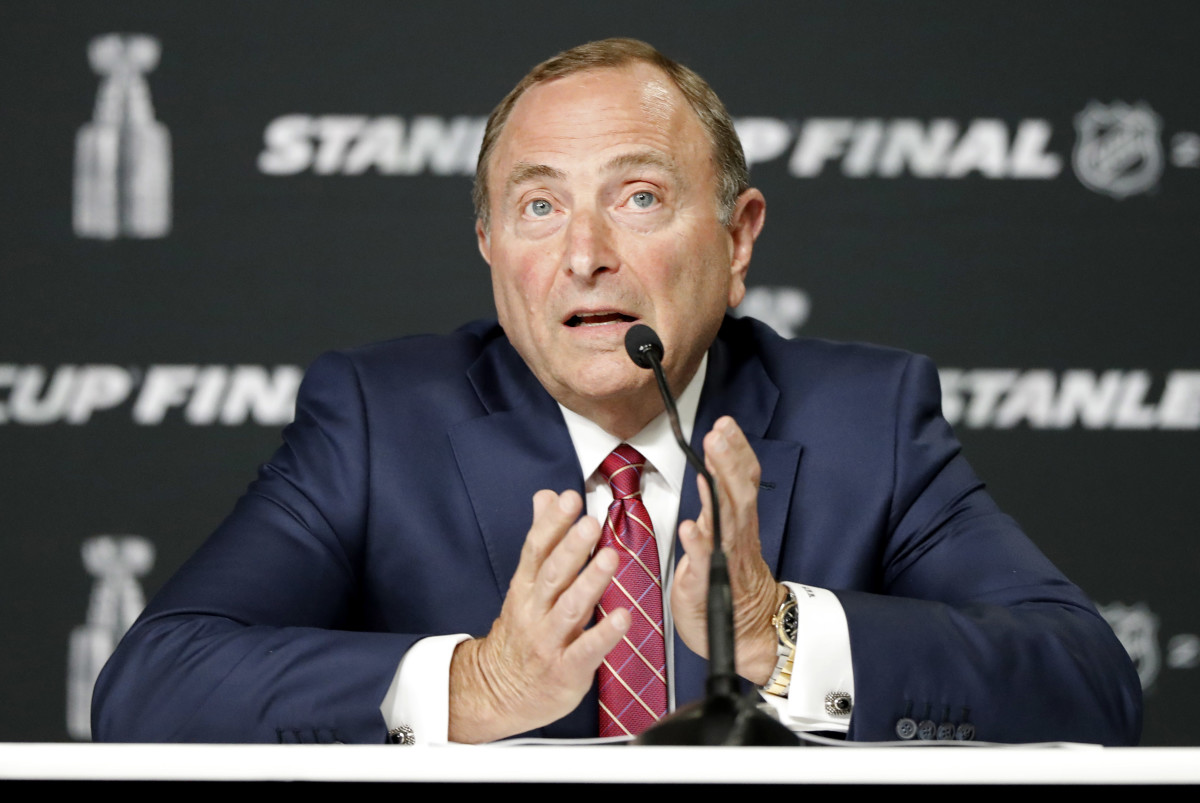The NHL's Big Test: Inside the League's Pandemic Response
On March 12, the day after Utah Jazz center Rudy Gobert tested positive for COVID-19 and the NBA postponed its season, the NHL Board of Governors held an emergency conference call to determine the league’s course of action. The most urgent business was completed without debate: After offering his recommendation that the NHL promptly suspend games too, commissioner Gary Bettman opened the floor for objections.
“There wasn’t a peep,” one governor says. “It was silent.”
That was the easy part. The hard part involved all of the questions that came next: What were the financial implications of freezing a billion-dollar business? When would the 2019–20 regular season and Stanley Cup playoffs resume, if ever? And, perhaps most pressingly, what should teams do if a player came down with symptoms of or tested positive for the novel coronavirus?

No one in NHL circles had been diagnosed at the time, but that was viewed by league officials as all but certain to change, in large part due to the frequent arena overlap among NHL and NBA teams. The previous night, Jazz players had been directed by the Oklahoma State Health Department to be tested for the virus in the visiting locker room at Chesapeake Energy Arena; their opponent, the Thunder, were now being instructed to do the same. With the nation facing a testing shortage, one NHL owner on the call wondered whether their team should consider obtaining them en masse for its players and personnel as a precaution.
“It was more in the form of a question,” deputy commissioner Bill Daly says. “As in, ‘Should we be pursuing that? Is that a way to address this issue?’ We said, very definitively, that our medical experts, including governing health authorities, aren’t recommending mass testing—in part because the resources aren’t available, in part because it’s of limited utility at this point.”
As the case count skyrocketed in the United States over the ensuing weeks, and thousands of Americans were killed by the virus, the topic of pro athletes and testing became a nationwide controversy. The government had advised the general population to seek tests only if symptoms emerged in an effort to conserve kits, but at least eight NBA teams ended up testing their full squads, many through private labs, resulting in positive results for asymptomatic players like the Celtics’ Marcus Smart, the Nets’ Kevin Durant, and two unnamed Lakers.
The backlash—from fans and reporters, medical professionals and public officials alike—was swift: “An entire NBA team should NOT get tested for COVID-19 while there are critically ill patients waiting to be tested,” New York City Mayor Bill DeBlasio tweeted about the Nets on March 17. “Tests should not be for the wealthy, but for the sick.” The matter was even raised at a White House coronavirus press briefing: "Perhaps that's the story of life,” President Donald Trump shrugged.
As waves of backlash hit the NBA—recasting a supposedly forward-thinking, progressive outfit as one of many prominent examples of the rich and famous receiving superior treatment amid the pandemic—the NHL has skated by virtually unnoticed. Seven hockey players had been diagnosed with COVID-19 through Wednesday, though five of those were members of the Senators and received tests at the direction of the Canadian health care system. The other two play for the Avalanche, who went through “two different public health agencies” and waited more than a week before obtaining results, Daly says.
In a league of 700-plus players and hundreds more coaches, equipment managers, athletic trainers, and other gameday staffers, more individuals almost certainly have contracted the virus but not been tested. “Right now, they’re doing the right thing in saying they’re not going to test in any way different than what’s recommended,” Dr. Natasha Crowcroft, director of the Centre for Vaccine Preventable Diseases at the University of Toronto, says of the NHL. “I applaud them for taking that stance. The message that one group gets special treatment is really not helpful.”
But with MLB pitchers continuing to undergo Tommy John surgery, the type of elective procedure many states have halted and the U.S. surgeon general has requested to stop, two of the three (normally) in-season major professional leagues have sent that very message.
So why has only the NHL not?

***
On March 13, after a day of coordinating with NHLPA representatives, Bettman’s office issued a leaguewide memo titled CORONAVIRUS DISEASE 2019 (COVID-19) MARCH 13, 2020 UPDATE: PAUSE OF SEASON, summarizing the details of the hiatus. Training facilities were closed, though an exception was made for injury rehab. Players and coaches were directed to self-quarantine, not to skate or practice until further notice. A dash of hope was included, as the NHL expressed full intentions to resume its season and award the ’19-20 Stanley Cup in the future … although exactly when that would happen was, and continues to be, unknown.
The memo also included the no-mass-testing recommendations that league officials had spelled out on the Board of Governors call. This was not, however, the NHL’s first communication on the subject: At least two earlier COVID-19-related memos had been issued to teams in the two weeks before the annual GM meetings in Boca Raton, Florida, in early March, says Daly, outlining best preventative practices according to the CDC and Health Canada.
“None of this is rocket science,” Daly says. “Everybody preaches the same thing: Testing should only be pursued when it’s medically indicated. For us, it was as simple as following the directions we were getting from the health authorities.”
To help with its decisions, the NHL has relied on the expertise of chief medical officer Dr. Willem Meeuwisse; a COVID-19-specific task force of some 15 representatives from different league departments, including hockey operations and club services, which meets for regular calls; and a previously existing infectious disease subcommittee chaired by Dr. Gary Dorshimer, the Flyers’ team physician. Not long after the season was officially paused on March 12, the league also enlisted an infectious disease specialist from Long Island named Dr. Bruce Farber, who continues to provide updates to the Board of Governors on a semiregular basis.
The consensus: With teams self-quarantining anyway during the hiatus, testing even mildly symptomatic players is ill-advised. “For the average person who’s just sitting at home anyway, and professional athletes should be doing that like everybody else, it’s not that important,” says Dr. Shira Doron, hospital epidemiologist at Boston’s Tufts Medical Center. “Now, back at that time, [tests] did give useful information that allowed the NBA to make decisions about canceling the season. But if it’s already canceled, there’s really no use for testing an asymptomatic person. … We need tests for people who are hospitalized, so we know how to treat them when they’re really sick.”
At least two NHL players—Coyotes defenseman Aaron Ness and Stars winger Alexander Radulov—tested negative after taking ill with coronavirus-like symptoms, though that number is likely larger. According to Daly, the NHL keeps a “master list” of tests obtained by anyone “associated with the league or our clubs,” players included, “but that’s not something we would ever share publicly.” Teams are also asked to alert the league if any staffer becomes symptomatic, making it unlikely that any player has been tested, say, at a private lab in secret without the NHL’s knowledge.
Though Daly says the NHL made its initial call against mass-testing before the NBA began receiving blowback, league officials quickly noticed the criticism facing their basketball counterparts. On March 18, the day after the Senators announced the NHL’s first case, a portion of an update memo sent to teams referenced the Nets’ three asymptomatic positive tests. Specifically, the memo noted how Brooklyn’s teamwide private testing had “once again raised questions publicly” about the usefulness of testing. The memo went on to emphasize that neither leaguewide nor clubwide testing of players was “recommended or encouraged.”
“Look, I think we knew what was being said in the media occasionally with respect to some of the NBA team experiences,” Daly says. “But I can’t say really that was at all pertinent to the decision we were making, because I think we were aligned from the start.”

***
Even so, teams explored contingency plans. One high-ranking NHL team official recounts contacting a private lab about the possibility of ordering mass tests in the event that a player became symptomatic. “Our question was: Do we have access? What is the turnaround time like?” the official says. “That was first and foremost. Then, when it became clear they did have testing availability, it was: What’s the moral and social concern with knowing that a lot of people need those tests and are extremely symptomatic, but they’re not available to the public?”
The tests were marked at $300 apiece, a rounding error in the budget of a major league franchise. But the team official recalls the lab growing “evasive” when probed about its business model. If their team decided not to buy these tests, the official wondered, would they simply be sold to the next person with deep enough pockets? What about if local hospitals were facing a shortage? Would the lab reduce its price to help needy people then? “They weren’t exactly transparent about what the process would be,” the official says. “They didn’t have a fair answer.”
The team eventually cut off talks, contacted the CDC and local health officials, and received assurance that tests were available should they ever become necessary, as the case count in that particular state was still low. Still, the official acknowledges the business side to mass testing in this economically—not to mention epidemiologically—uncertain time. It is in a team’s interest to test its players, even if it is not in society’s. “If you were faced with a player who was symptomatic and you didn’t have access to public testing, or it was going to take a long period of time,” the team official says, “it would be a difficult decision to make.”
If the NBA has an official policy on teamwide testing, the league has not shared it with fans or media. But the decision by teams to go ahead with testing their full rosters has been publicly explained in a variety of ways. Both NBA spokesman Mike Bass and NBPA director Michele Roberts expressed concern in statements about players becoming “super spreaders” as frequent travelers. But that rationale went bunk once the season was postponed and players were largely confined, like the rest of us, to their homes. Bass also leaned on the idea that, by making its test results public, the league had done a social service.
In a statement to SI, an NBA spokesman said: “Team physicians and infectious disease specialists, in consultation with public health officials, made individual determinations on testing of players and staff based on their symptoms, exposure to others who have tested positive or exhibited symptoms consistent with COVID-19, and unique workplace circumstances of professional sports and the related risk of further spreading the virus.”
“I think it’s a fair comment to say they’ve managed to raise awareness in showing who’s positive,” says Crowcroft, the University of Toronto disease specialist. “But I don't think that argument is needed anymore. We’re in crisis mode.”
Indeed, as doctors and nurses report to the front lines of the coronavirus fight in understaffed, under-equipped hospitals across the country, athletes are simply tasked with staying home. The NHL recently extended its players’ self-quarantine period through April 15. The scouting combine and draft, originally scheduled for June 1–6 and June 26–27, respectively, have also been postponed.
In another Board of Governors call on Monday, March 23, Farber, the infectious disease consultant, came on the line for a coronavirus briefing. Discussing the likely health measures that the NHL would have to enact before resuming play, Farber brought up the need for widespread point-of-care testing units in the U.S., which can provide rapid, accurate results. (Promising versions have in recent days been approved by the FDA.) “He went on to say there’s just not enough of them at this point,” Daly recalls. “But he thought that POC tests could be very helpful potentially for parties like NHL teams who may want to screen players.”
And so, for now, the mandate is status quo. Each day Daly sends a coronavirus-related memo that one team official likened to a newsletter, full of everything from CBA-related issues to medical information to updates on other hockey leagues around the world. In most of them, if not all, a reminder is included about the recommendation against mass testing.
As Daly says, “That’s been hammered home very frequently.”
